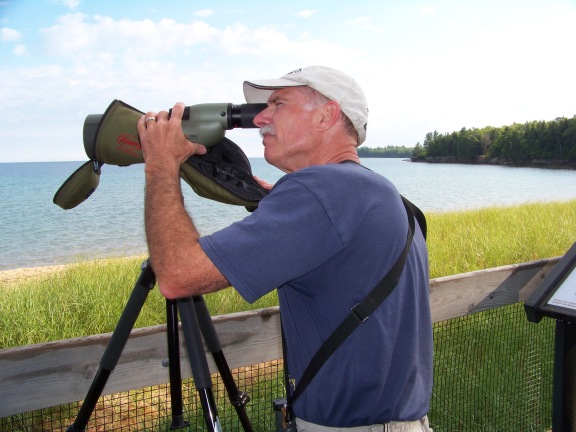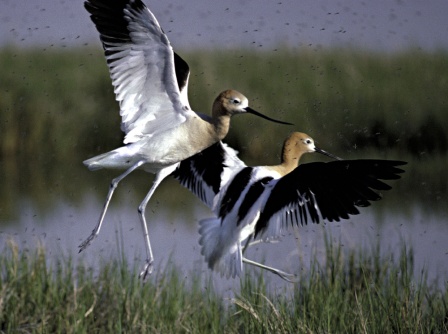
Scott Hickman scans for birds at The Face in the Rock/Scott Falls pull-off at Au Train Beach in Michigan’s Upper Peninsula. Photo courtesy of Scott Hickman.
By Howard Meyerson
Scott Hickman admits to being a rare bird enthusiast, someone who enjoys looking for the unusual find. Rare, of course, is a relative term.
For the 62-year-old retired college biology professor and member of Laughing Whitefish Audubon Society, it means rare birds for Alger County, a wild and largely undeveloped part of the northeast Upper Peninsula and home to the Pictured Rocks National Lakeshore.
“It’s amazing what you can find if you are diligent,” said Hickman, who considers himself a “home-county” lister, someone who focuses only on birds in their county, learning every nook and cranny where they might be seen.
“Past a certain point you have all the common birds,” Hickman said. “Then, what I try to do is be in the right habitat at the right time of year when something really rare shows up.”
Take, for example, the American Avocet he spotted in 2009. Hickman found it on Au Train Beach at the mouth of the Au Train River. Avocets are long-legged shorebirds that breed in the central and western U.S. and Canada, from Minnesota to Washington to

Hickman spotted American Avocets on August 20, 2009 after visiting Au Train Beach for 34 days. Photo: U.S. Fish & Wildlife Service.
points south. Hickman spotted it on August 20th after visiting the beach for 34 days.
“I needed the American Avocet for my county list and knew a local stretch of beach with good habitat,” said Hickman who lives in Shelter Bay with his wife Debbie, “I went to that beach every day. One day – bang – there it was.”
ONLINE CHATTER HELPED
Finding it there relied on more than hunch. Hickman had followed the online chatter within the birding community. Avocets were being seen in Upper Midwest areas, moving in larger numbers than usual.
“I thought: ‘This might be the year one of those rascals shows up,’” he said.
Hickman’s friends refer to him as focused, deliberate, and methodical, and “an animal” when it comes to finding birds in his county. His dedication to home-county listing occasionally makes him the target of friendly ribbing.
Rare-bird chasers more typically jump on the highway at any hour to cross the state, even leaving family behind, when they get wind of a good find. But not Scott Hickman; if it’s in the next county someone else will have to find it.
“Scott has his turf marked out and doesn’t like to stray too far from it,” said Skye Haas, chairman of Laughing Whitefish Audubon Society in Marquette and a personal friend.
“He’s a fantastic guy, but we will poke good-natured fun at him for being an Alger County birder and tell him he should try going somewhere else. Scott’s birding skills are amazing and he has encyclopedic knowledge about his quarries.”
OTHER RARE SIGHTINGS
Hickman’s other rare sightings include a Yellow-billed Loon he found on Munising Bay in 2012. It was only the second-ever sighting in Michigan. But his “most exciting find” was a Yellow Rail found in 2008. The diminutive marsh bird had been documented 40-

Hickman found a Yellow Rail after bushwacking through a swamp. Photo: Dominic Sherony, Wikimedia Commons.
to 50-years before in an area east of Shingleton. Hickman didn’t know of any viable habitat there. The Yellow Rail requires grassy, marshland or wet meadow habitat.
“I thought where the devil would one be east of Shingleton?” Hickman said. “So, I skied, hiked and kayaked into areas and went out and played tapes at night.
“Eventually I found a photo atlas of the area and habitat on the south side of M-28. I bushwhacked almost a mile through a wetland area early in the morning and, by God, they were calling.”
BEGINNINGS IN ILLINOIS
Hickman grew up in southern Illinois. As a child he spent a lot of time in the woods. Neither of his parents was into nature or the outdoors. His father was fascinated by airplanes and flight and took to building hand-launched gliders for fun.
How things fly and in particular how the shape of wings helps them, remains an interest for Hickman, but his love of birds and birdwatching grew out of an experience in graduate school, while working as a teaching assistant at Illinois State University. His professor, Dale Birkenholz, invited him out birdwatching one day. The two of them found a large assortment of warblers. The experience opened his eyes.
“I thought: I am an idiot. I didn’t realize that this huge diversity of birds existed. I was taking a course in evolutionary ecology and there was a lot of theoretical work done with birds. It was so aesthetically pleasing to be birding, and the course was so intellectually challenging, that the combination rang my bells. I just stayed with it and got very interested.”
Hickman went to on to get his Ph.D. in Biology at the University of Illinois and taught college biology, ecology and human anatomy at community colleges in Illinois until 2002. Then the lure of retirement beckoned and he and his wife moved to Michigan’s Upper Peninsula.
The U.P., he said, is an excellent place for birdwatching, something he does for several hours every day.
Hickman maintained his birding interests also getting involved with the Michigan Bird Records committee and consulting for natural resources agencies in Illinois and Michigan by doing bird population surveys.
Hickman also authored two sections of the second edition of the Michigan Breeding Bird Atlas, writing the discussions about the Boreal Chickadee and Gray Jay.
“I really like northern species,” Hickman said. “They scream out North Woods.”
This is why he and his wife settled in the Upper Peninsula surrounded by the natural environs of Lake Superior, the Hiawatha National Forest and Pictured Rocks National Lakeshore.
“We’re here for three reasons,” Hickman said. “There is more snow, fewer people, good birding – and we are within day’s drive of the kids and grandkids in Illinois.
“I love being out by myself, in the middle of nowhere looking for birds. I love the feel of that solitude. It’s a real thrill to do it day after day.”
__________________________________
This feature appears in the Michigan Audubon Society Jack Pine Warbler.

He even inspires neighbors to “bird”.
LikeLike